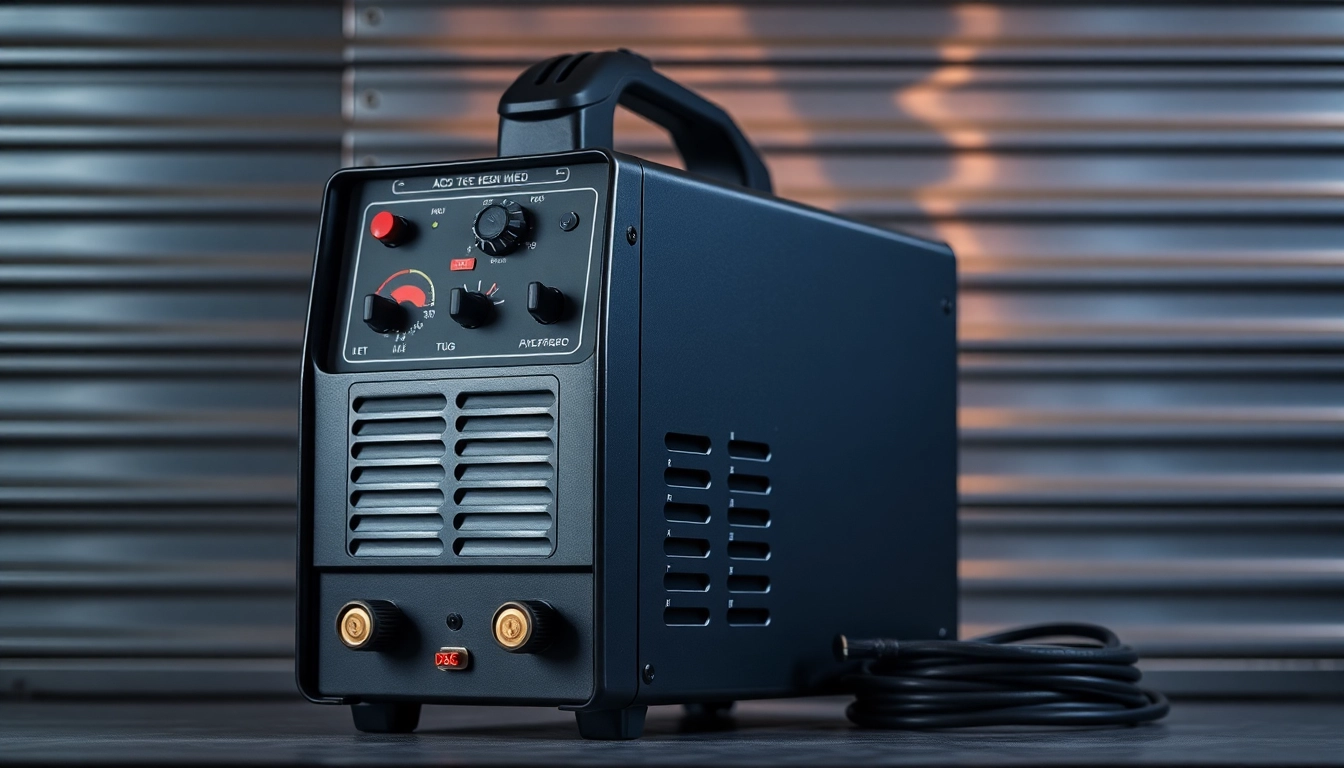Understanding AC DC TIG Welders
Welding is a critical skill used across numerous industries, from construction to automotive repair. Among the various methods for welding, ac dc tig welder technology has gained considerable popularity due to its versatility and precision. This article aims to explore the ins and outs of AC DC TIG welders, helping readers understand their features, benefits, applications, and more.
What is an AC DC TIG Welder?
An AC DC TIG welder is a type of welding equipment that uses both alternating current (AC) and direct current (DC) to create high-quality welds. The capability to switch between AC and DC provides flexibility, allowing users to work with a variety of materials. While AC is primarily used for welding aluminum, DC is more suitable for welding metals like stainless steel and mild steel. This dual functionality makes AC DC TIG welders a preferred choice among professionals and hobbyists alike.
Benefits of AC DC TIG Welding
AC DC TIG welding offers numerous advantages, making it an attractive option for many welders:
- Versatility: The ability to use both AC and DC allows for welding of different materials, ranging from aluminum to copper.
- Precision: TIG welding produces cleaner, finer welds compared to other welding methods due to the focused arc and gas shielding.
- Control: Welders have greater control over the heat input and output during the welding process, reducing the risk of warping and burn-through.
- Application in Thin Materials: TIG welding excels when working with thin materials, which is a common requirement in aerospace, automotive, and artistic projects.
Differentiating Features of AC vs. DC
Understanding the differences between AC and DC is crucial for selecting the right welder for your project:
- AC (Alternating Current): Best for welding aluminum and magnesium, AC has a cleaning action that removes oxides from the base metal, creating a better bond. This cleaning cycle can lead to a smoother finish.
- DC (Direct Current): Ideal for welding materials like steel and stainless steel, DC offers more stable arc characteristics and allows for deeper penetration.
Choosing the Best AC DC TIG Welder
When purchasing an AC DC TIG welder, several factors come into play that can influence your decision:
Key Features to Consider
Before finalizing a purchase, it’s essential to consider the following features:
- Power Output: Select a welder that provides adequate amperage for the thickness of the materials you intend to work with. Most AC DC TIG welders offer an output range of between 200 to 300 amps.
- Duty Cycle: This refers to the welder’s ability to operate continuously without overheating. A higher duty cycle means longer periods of use without the need for downtime.
- Weight and Portability: If you plan to move your welder around frequently, consider its weight and form factor. Some welders come with built-in wheels for easier transport.
- Control Options: Look for welders with user-friendly controls, such as digital displays and adjustable parameters, which can enhance accuracy and ease of use.
- Accessories Included: Some welders come with necessary accessories like foot pedals, gas regulators, and more, which can add value to your investment.
Comparing Top Brands
Numerous brands offer AC DC TIG welders, each with unique strengths. Here are a few renowned brands to consider:
- Lincoln Electric: Known for its reliable and robust welding equipment, Lincoln offers a variety of AC DC TIG models that cater to both beginners and seasoned professionals.
- Miller Electric: Miller welders are highly regarded for their durability and performance. They often come with advanced features, including Auto-Set technology for ease of use.
- Everlast: Everlast welders are popular for their affordability without compromising on quality. They provide a wide range of options for hobbyists and professionals alike.
- Weldpro: Weldpro focuses on innovative technology and user-friendly designs, appealing to a wide range of welding enthusiasts.
Budgeting for Your Welder
Your budget will have a significant impact on your choice of welder. Typically, a good AC DC TIG welder will cost anywhere from $500 to $3000, depending on the features and brand. Here are some pricing guidelines:
- Entry-Level Models: $500 – $1000: Suitable for beginners and occasional DIY projects.
- Mid-Range Models: $1000 – $2000: Ideal for serious hobbyists and light commercial use.
- Professional Models: $2000 and above: Designed for frequent, heavy-duty use in professional settings.
Common Uses of AC DC TIG Welders
AC DC TIG welders are employed in a variety of applications across different industries:
Welding Aluminum vs. Other Metals
One of the most notable advantages of AC DC TIG welding is its effectiveness in joining aluminum, which can be challenging to weld due to its oxidation. Unlike other welding types, TIG can create strong, clean welds on aluminum, making it a preferred method in the automotive and aerospace sectors. Additionally, DC TIG welding excels with metals like stainless steel and copper, where penetration and precise control over the heat are needed.
Applications in Various Industries
AC DC TIG welding finds extensive usage in various sectors:
- Aerospace: Creating precise welds on aircraft materials, including aluminum and titanium.
- Automotive: Repairing and fabricating components, particularly in custom builds and restorations.
- Manufacturing: Used for creating medical devices, food processing equipment, and more, where cleanliness and precision are paramount.
- Artistic Welding: Artists and sculptors use TIG welding for intricate art pieces where aesthetics and clean lines matter.
Safety Precautions While Welding
While TIG welding is relatively safe, following basic safety protocols is crucial to prevent accidents:
- Wear Protective Gear: Always wear a welding helmet with proper lens shade, gloves, and protective clothing to shield your skin from UV light and sparks.
- Ensure Ventilation: Work in a well-ventilated area to avoid inhaling harmful fumes.
- Check Equipment: Regularly inspect your welder and cables for signs of wear or damage before each use.
Tips for Optimal Performance
To ensure your AC DC TIG welder operates efficiently and reliably, consider the following tips:
Maintenance and Care
Regular maintenance is essential for the longevity and performance of your welding machine:
- Clean Regularly: Remove dust and debris from the welder to prevent overheating and reduce wear on components.
- Inspect Consumables: Frequently check your tungsten electrodes and filler rods. Replace them when worn or contaminated.
- Store Properly: Keep your welder covered and stored in a dry environment to protect it from moisture and dust.
Common Troubleshooting Techniques
Even the best welders can face issues. Here are some common problems and their solutions:
- Weak or Inconsistent Arc: Check the gas flow rate, ensure proper electrode size, and confirm settings match the material thickness.
- Excessive Spatter: Adjust your gas settings, clean the base material thoroughly, and check the electrode for contamination.
- Poor Penetration: Increase your amperage or reduce travel speed to enhance penetration depth.
Improving Welding Skills with Practice
Mastery of TIG welding techniques often requires practice. Below are some effective ways to enhance your skills:
- Take Classes: Enroll in local welding courses to learn from experienced instructors.
- Join Welding Communities: Engage with other welders online or in-person to exchange tips and experiences.
- Experiment: Practice on different materials and settings to understand how various factors affect your welding quality.
Future of AC DC TIG Welding
The future of AC DC TIG welding is closely tied to innovations in technology and practices within the industry. Let’s explore some emerging trends:
Innovative Technologies on the Horizon
As technology advances, so does the welding industry. Some of the innovative trends in TIG welding include:
- Inverter Technology: New inverter technology significantly reduces the size and weight of welders without sacrificing power.
- Digital Controls: Increased integration of digital displays and settings enhances user experience and precision.
- Pulse TIG Welding: Pulse welding is becoming more popular as it allows for better control and improved weld quality, especially on thin materials.
Sustainability in Welding Practices
The push for sustainability is affecting all areas of manufacturing, including welding. Key areas of focus include:
- Minimizing Waste: New strategies are being developed to reduce waste during the welding process, promoting a more sustainable approach to fabrication.
- Energy Efficiency: Modern welders are designed with improved energy efficiency, consuming less power while maintaining performance.
- Recyclable Materials: Manufacturers are increasingly using recyclable materials in their products, encouraging a circular economy in the welding industry.
Community Insights and Trends
As with many other industries, the welding community is a source of valuable insights and emerging trends. Participating in forums can help keep you updated on:
- Latest equipment reviews and recommendations from other users.
- Tips on best practices from experienced welders.
- Insights into developing trends, such as the use of robotics in welding.



